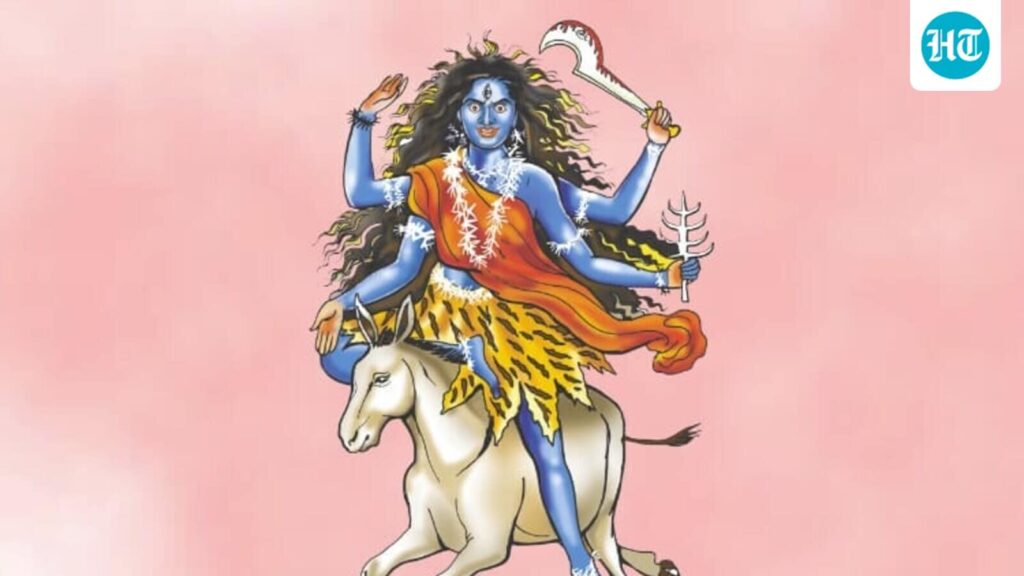Navratri day 7: Navratri is a celebration of the divine feminine energy and the triumph of good over evil. It’s a time for spiritual growth, self-reflection, and devotion. The festival is observed with fasting and prayer. The nine goddesses worshipped during Navratri are collectively known as Navadurga, representing different aspects of the divine feminine. Maa Kalaratri is the seventh form of Goddess Durga, worshipped on the seventh day of Navratri. Also read | Navratri colours 2025: Complete list of 9 colours of Navratri, their significance and goddess to worship each day
Navratri day 7: Who is Maa Kalaratri?
Each day of Navratri is dedicated to a different form of Goddess Durga, representing various aspects of the divine feminine. Devotees fast, pray, and perform rituals to seek the blessings of the goddess.
Maa Kalaratri is worshipped on Navratri day 7. She’s a fierce and powerful deity, often depicted with a dark complexion, dishevelled hair, and four hands carrying a sword, iron hook, and two mudras – abhaya (fearlessness) and varada (boon-giving). Her vehicle is a donkey, symbolising humility and service.
Maa Kalaratri’s legend is associated with the demon Raktabeej, whose blood drops created new demons. It is said that she drank his blood to prevent more demons from being born, ultimately killing him and saving the world from destruction – this story symbolises the end of desires and negative tendencies.
Significance and worshipping Maa Kalaratri
Praying to Maa Kalaratri is believed to remove fear and negativity as she protects her devotees from evil spirits, negative energies, and fear. Maa Kalaratri is also beleived to provide the courage to face challenges and overcome inner darkness, and her worship activates the sahasrar (crown) chakra, leading to divine awakening and spiritual liberation. Maa Kalaratri is associated with planet Shani (Saturn), and it is said that worshipping her can alleviate Shani dosha.
Navratri day 7 colour associated with Maa Kalaratri
Navratri colours are an integral part of the festival, each representing a unique energy and significance. These colours are associated with the nine forms of Goddess Durga, worshipped during the nine-day celebration. To worship Maa Kalaratri, devotees typically wear orange. Signifying energy, transformation, and positivity, orange is believed to fill devotees with warmth, courage, and enthusiasm. It represents enthusiasm, warmth, and optimism and is full of positive energy.
Maa Kalaratri mantra and aarti
On day 7 of Navratri, devotees offer jaggery, sesame seeds, and flowers as offerings to the goddess and chant mantras such as ‘Om Devi Kalaratryai Namah’ and ‘Ya Devi Sarvabhuteshu Maa Kalaratri Rupena Samsthita’. Devotees also sing Maa Kalaratri’s aarti, invoking her power to destroy evil and protect her followers.
Maa Kalaratri’s aarti is a powerful way to seek her blessings for courage, protection, and removal of fear. Here’s a commonly recited version:
Kalratri jaya-jaya-Mahakali, Kal ke muh se bachane vali
Dushta sangharak nam tumhara, Mahachandi tera avatar
Prithvi aur akash pe sara, Mahakali hai tera pasara
Khaad Khaper rakhne vali, Duston ka lahu chakhne vali
Kalkatta sthan tumhara, Sab jagah dekhun tumhara najara
Sabhi devta sab nar-nari, Gaven stuthi sabhi tumhari
Rakhtadanta aur Annapurna, Kripa kare to koi dukh na
Na koi chinta rahe bimari, Na koi gham na sankat bhari
Us par kabhi kashta na ave, Mahakali maa jise bachave
Tu bhi bhakt prem se kah, Kalratri maa teri jai
Note to readers: This story includes AI-generated elements.

